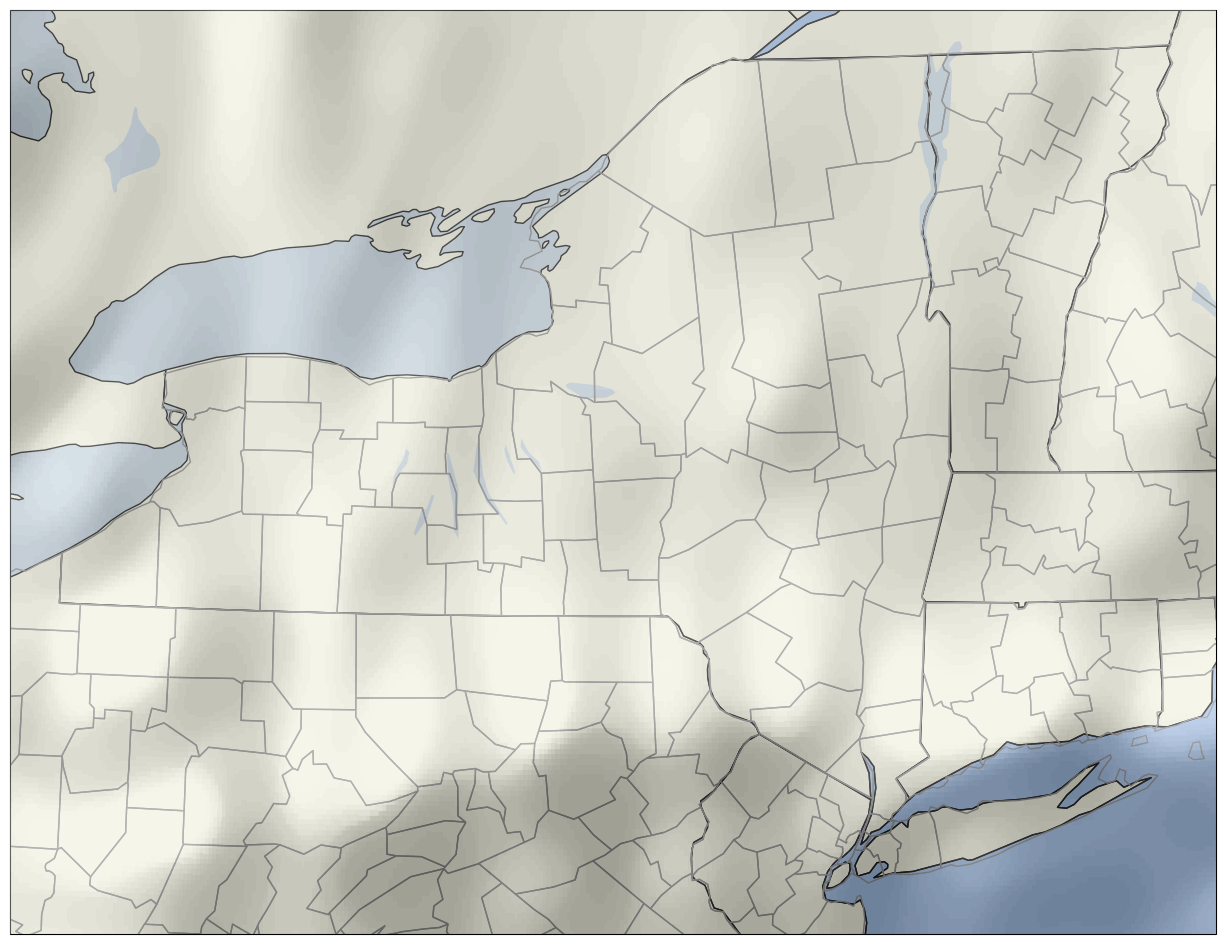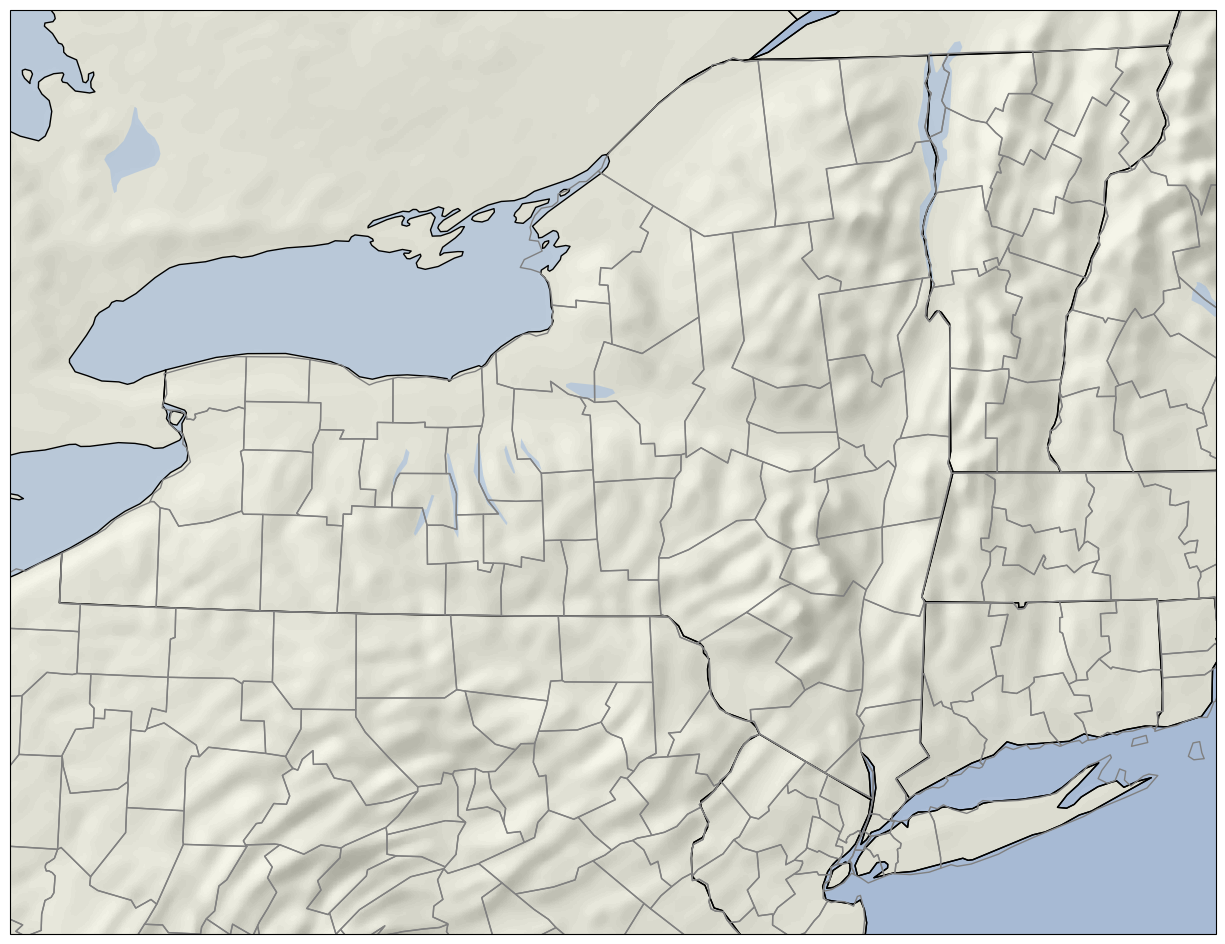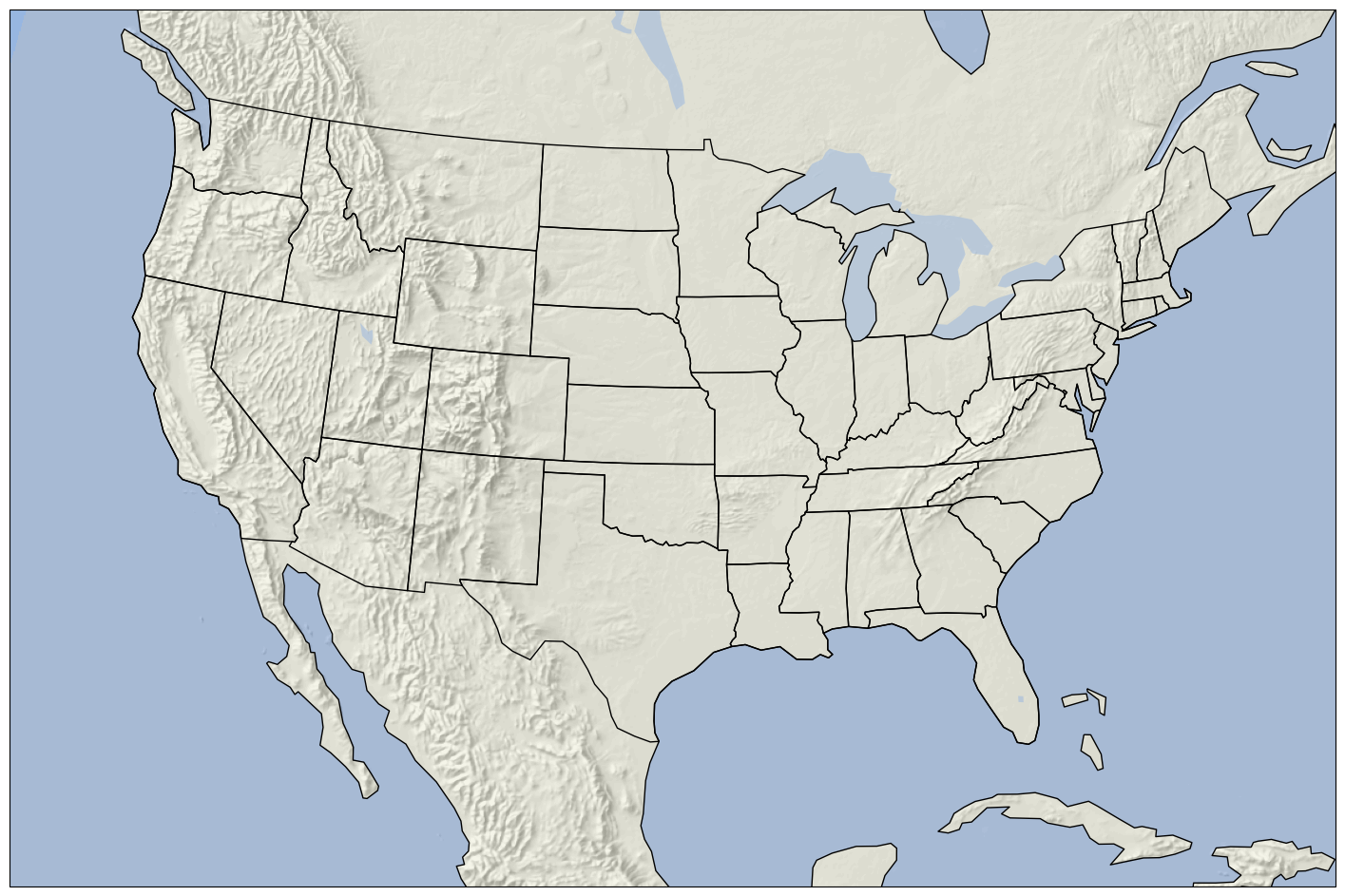Rasters 2: Overlays
Contents
Rasters 2: Overlays¶
Overview¶
Read in a raster file in GeoTIFF format of surface elevation using the Rioxarray package
Explore the attributes of the GeoTIFF file
Plot the GeoTIFF using Matplotlib and Cartopy
Overlay the GeoTIFF on a plot of realtime forecast reflectivity data
Prerequisites¶
Concepts |
Importance |
Notes |
|---|---|---|
Rasters 1 |
Necessary |
Time to learn: 30 minutes
Be sure to close and shutdown the notebook when finished!
Imports¶
from datetime import datetime, timedelta
import pandas as pd
import matplotlib.pyplot as plt
import cartopy.crs as ccrs
import cartopy.feature as cfeat
import numpy as np
import xarray as xr
from metpy.plots import USCOUNTIES
from metpy.plots import ctables
import rioxarray as rio
from matplotlib.colors import BoundaryNorm
from matplotlib.ticker import MaxNLocator
ERROR 1: PROJ: proj_create_from_database: Open of /knight/anaconda_aug22/envs/aug22_env/share/proj failed
rioxarray library, we've also imported USCOUNTIES from MetPy. This allows for the plotting of US county line boundaries, similar to other Cartopy cartographic features such as states.Additonally, we've imported a set of color tables, also from MetPy.
We've also imported a couple additional methods from Matplotlib, which we'll use to customize the look of our plot when using the
imshow method.
Read in a raster file in GeoTIFF format¶
Process the topography GeoTIFF file, downloaded from Natural Earth, using the rioxarray package. This package provides an xarray interface while also presenting functionality similar to the rasterio library.
msr = rio.open_rasterio('/spare11/atm533/data/raster/US_MSR_10M/US_MSR.tif')
Explore the GeoTIFF file. Remember, it’s a TIFF file that is georeferenced.
msr
<xarray.DataArray (band: 1, y: 9493, x: 12578)>
[119402954 values with dtype=uint8]
Coordinates:
* band (band) int64 1
* x (x) float64 -1.492e+07 -1.492e+07 ... -5.789e+06 -5.788e+06
* y (y) float64 7.56e+06 7.559e+06 ... 6.678e+05 6.671e+05
spatial_ref int64 0
Attributes:
scale_factor: 1.0
add_offset: 0.0spatial_ref. This coordinate variable's attributes includes CRS info in what's called well-known text (WKT) format, as well as the Affine transformation parameters. See references at the end of this notebook.
Get the bounding box coordinates of the raster file. We will need to pass them to Matplotlib’s imshow function.
left,bottom,right,top = msr.rio.bounds()
left,bottom,right,top
(-14920200.0, 666726.142827049, -5787726.0672549475, 7560000.0)
These values represent the coordinates, in units specific to the GeoTIFF’s geographic coordinate reference system, of the lower-left and upper-right corners of the raster file.
Get the projection info, which we can later use in Cartopy. A rioxarray dataset object has an attribute called crs for this purpose.
msr.rio.crs
CRS.from_epsg(3857)
Assign this CRS to a Cartopy projection object.
projMSR = ccrs.epsg('3857')
Examine the spatial_ref attribute of this Dataset.
msr.spatial_ref
<xarray.DataArray 'spatial_ref' ()>
array(0)
Coordinates:
spatial_ref int64 0
Attributes:
crs_wkt: PROJCS["WGS 84 / Pseudo-Mercator",GEOGCS["WGS 84",DATUM["W...
spatial_ref: PROJCS["WGS 84 / Pseudo-Mercator",GEOGCS["WGS 84",DATUM["W...
GeoTransform: -14920200.0 726.0672549487241 0.0 7560000.0 0.0 -726.14282...This information makes it possible for GIS applications, such as Cartopy, to transform data that’s represented in one CRS to another.
Select the first (and only) band and redefine the DataArray object, so it only has dimensions of x and y.
msr = msr.sel(band=1)
Determine the min and max values.
msr.min(),msr.max()
(<xarray.DataArray ()>
array(113, dtype=uint8)
Coordinates:
band int64 1
spatial_ref int64 0,
<xarray.DataArray ()>
array(249, dtype=uint8)
Coordinates:
band int64 1
spatial_ref int64 0)
The next cell will determine how the topography field will be displayed on the figure. These settings work well for this dataset, but obviously must be customized for use with other raster images. This is akin to setting contour fill intervals, but instead of using Matplotlib’s contourf method, we will use imshow, and take advantage of the two Matplotlib methods we imported at the start of the notebook.
# Pick a binning (which is analagous to the # of fill contours, and set a min/max range)
levels = MaxNLocator(nbins=30).tick_values(msr.min(), msr.max()-20)
# Pick the desired colormap, sensible levels, and define a normalization
# instance which takes data values and translates those into levels.
# In this case, we take a color map of 256 discrete colors and normalize them down to 30.
cmap = plt.get_cmap('gist_gray')
norm = BoundaryNorm(levels, ncolors=cmap.N, clip=True)
Examine the levels.
levels
array([112., 116., 120., 124., 128., 132., 136., 140., 144., 148., 152.,
156., 160., 164., 168., 172., 176., 180., 184., 188., 192., 196.,
200., 204., 208., 212., 216., 220., 224., 228., 232.])
Plot the GeoTIFF using Matplotlib and Cartopy¶
Create a region over which we will plot … in this case, centered over NY State.
latN_sub = 45.2
latS_sub = 40.2
lonW_sub = -80.0
lonE_sub = -71.5
cLat_sub = (latN_sub + latS_sub)/2.
cLon_sub = (lonW_sub + lonE_sub )/2.
proj_sub = ccrs.LambertConformal(central_longitude=cLon_sub,
central_latitude=cLat_sub,
standard_parallels=[cLat_sub])
Plot the GeoTIFF using imshow. Just as we’ve previously transformed data from PlateCarree (lat/lon), here we transform from the Web Mercator projection that the elevation raster file uses.
res = '50m' # Use the medium resolution Natural Earth shapefiles so plotting goes a bit faster than with the highest (10m)
fig = plt.figure(figsize=(18,12))
ax = plt.subplot(1,1,1,projection=proj_sub)
ax.set_extent((lonW_sub,lonE_sub,latS_sub,latN_sub),crs=ccrs.PlateCarree())
ax.add_feature (cfeat.LAND.with_scale(res))
ax.add_feature (cfeat.OCEAN.with_scale(res))
ax.add_feature(cfeat.COASTLINE.with_scale(res))
ax.add_feature (cfeat.LAKES.with_scale(res), alpha = 0.5)
ax.add_feature (cfeat.STATES.with_scale(res))
ax.add_feature(USCOUNTIES,edgecolor='grey', linewidth=1 );
im = ax.imshow(msr,cmap=plt.get_cmap('gist_gray'),
alpha=0.4,norm=norm,transform=projMSR, zorder=10)

imshow is extent. The default values are not what we want; instead, we use the Bounding Box values that we read in earlier. See the documentation for extent in imshow's documentation.res = '50m'
fig = plt.figure(figsize=(18,12))
ax = plt.subplot(1,1,1,projection=proj_sub)
ax.set_extent((lonW_sub,lonE_sub,latS_sub,latN_sub),crs=ccrs.PlateCarree())
ax.add_feature (cfeat.LAND.with_scale(res))
ax.add_feature (cfeat.OCEAN.with_scale(res))
ax.add_feature(cfeat.COASTLINE.with_scale(res))
ax.add_feature (cfeat.LAKES.with_scale(res), alpha = 0.5)
ax.add_feature (cfeat.STATES.with_scale(res))
ax.add_feature(USCOUNTIES,edgecolor='grey', linewidth=1)
# Pass in the bounding box coordinates as the value for extent
im = ax.imshow(msr, extent = [left,right,bottom,top],cmap=plt.get_cmap('gist_gray'),
alpha=0.4,norm=norm,transform=projMSR);

That’s more like it! Now, we can plot maps that include one (or more) GeoTIFF raster images, while also overlaying meteorological data, such as point observations or gridded model output.
Overlay the GeoTIFF on a plot of realtime forecast reflectivity data¶
Below, we go through the same steps that we did in the first Raster notebook to gather the latest HRRR model output, but plot filled contours of forecasted 1km above ground level radar reflectivity over the background of topography. We’ll plot over the CONUS.
now = datetime.now()
year = now.year
month = now.month
day = now.day
hour = now.hour
minute = now.minute
print (year, month, day, hour,minute)
if (minute < 45):
hrDelta = 3
else:
hrDelta = 2
runTime = now - timedelta(hours=hrDelta)
runTimeStr = runTime.strftime('%Y%m%d %H00 UTC')
modelDate = runTime.strftime('%Y%m%d')
modelHour = runTime.strftime('%H')
modelDay = runTime.strftime('%D')
print (modelDay)
print (modelHour)
print (runTimeStr)
2023 1 19 17 33
01/19/23
14
20230119 1400 UTC
data_url = 'https://thredds.ucar.edu/thredds/dodsC/grib/NCEP/HRRR/CONUS_2p5km/HRRR_CONUS_2p5km_'+ modelDate + '_' + modelHour + '00.grib2'
ds = xr.open_dataset(data_url)
refl = ds.Reflectivity_height_above_ground
refl
<xarray.DataArray 'Reflectivity_height_above_ground' (time: 19,
height_above_ground1: 1,
y: 1377, x: 2145)>
[56119635 values with dtype=float32]
Coordinates:
* x (x) float32 -2.763e+03 -2.761e+03 ... 2.682e+03
* y (y) float32 -263.8 -261.3 ... 3.228e+03 3.231e+03
reftime datetime64[ns] 2023-01-19T14:00:00
* time (time) datetime64[ns] 2023-01-19T14:00:00 ... 2023-...
* height_above_ground1 (height_above_ground1) float32 1e+03
Attributes:
long_name: Reflectivity @ Specified height level ab...
units: dB
abbreviation: REFD
grid_mapping: LambertConformal_Projection
Grib_Variable_Id: VAR_0-16-195_L103
Grib2_Parameter: [ 0 16 195]
Grib2_Parameter_Discipline: Meteorological products
Grib2_Parameter_Category: Forecast Radar Imagery
Grib2_Parameter_Name: Reflectivity
Grib2_Level_Type: 103
Grib2_Level_Desc: Specified height level above ground
Grib2_Generating_Process_Type: Forecast
Grib2_Statistical_Process_Type: UnknownStatType--1Select the time index (corresponding to the forecast hour; index 0 corresponds to the analysis time) and the (single) height index.
idxTime = 0
idxHght = 0
validTime = refl.time1.isel(time1 = idxTime).values # Returns validTime as a NumPy Datetime 64 object
validTime = pd.Timestamp(validTime) # Converts validTime to a Pandas Timestamp object
timeStr = validTime.strftime("%Y-%m-%d %H%M UTC") # We can now use Datetime's strftime method to create a time string.
tl1 = "HRRR 1km AGL Reflectivity (dBZ)"
tl2 = str('Valid at: '+ timeStr)
title_line = (tl1 + '\n' + tl2 + '\n')
---------------------------------------------------------------------------
AttributeError Traceback (most recent call last)
Input In [20], in <cell line: 3>()
1 idxTime = 0
2 idxHght = 0
----> 3 validTime = refl.time1.isel(time1 = idxTime).values # Returns validTime as a NumPy Datetime 64 object
4 validTime = pd.Timestamp(validTime) # Converts validTime to a Pandas Timestamp object
5 timeStr = validTime.strftime("%Y-%m-%d %H%M UTC") # We can now use Datetime's strftime method to create a time string.
File /knight/anaconda_aug22/envs/aug22_env/lib/python3.10/site-packages/xarray/core/common.py:256, in AttrAccessMixin.__getattr__(self, name)
254 with suppress(KeyError):
255 return source[name]
--> 256 raise AttributeError(
257 f"{type(self).__name__!r} object has no attribute {name!r}"
258 )
AttributeError: 'DataArray' object has no attribute 'time1'
refl = ds.Reflectivity_height_above_ground.isel(time1=idxTime, height_above_ground1=idxHght)
---------------------------------------------------------------------------
ValueError Traceback (most recent call last)
Input In [21], in <cell line: 1>()
----> 1 refl = ds.Reflectivity_height_above_ground.isel(time1=idxTime, height_above_ground1=idxHght)
File /knight/anaconda_aug22/envs/aug22_env/lib/python3.10/site-packages/xarray/core/dataarray.py:1291, in DataArray.isel(self, indexers, drop, missing_dims, **indexers_kwargs)
1286 return self._from_temp_dataset(ds)
1288 # Much faster algorithm for when all indexers are ints, slices, one-dimensional
1289 # lists, or zero or one-dimensional np.ndarray's
-> 1291 variable = self._variable.isel(indexers, missing_dims=missing_dims)
1292 indexes, index_variables = isel_indexes(self.xindexes, indexers)
1294 coords = {}
File /knight/anaconda_aug22/envs/aug22_env/lib/python3.10/site-packages/xarray/core/variable.py:1223, in Variable.isel(self, indexers, missing_dims, **indexers_kwargs)
1199 """Return a new array indexed along the specified dimension(s).
1200
1201 Parameters
(...)
1219 indexer, in which case the data will be a copy.
1220 """
1221 indexers = either_dict_or_kwargs(indexers, indexers_kwargs, "isel")
-> 1223 indexers = drop_dims_from_indexers(indexers, self.dims, missing_dims)
1225 key = tuple(indexers.get(dim, slice(None)) for dim in self.dims)
1226 return self[key]
File /knight/anaconda_aug22/envs/aug22_env/lib/python3.10/site-packages/xarray/core/utils.py:850, in drop_dims_from_indexers(indexers, dims, missing_dims)
848 invalid = indexers.keys() - set(dims)
849 if invalid:
--> 850 raise ValueError(
851 f"Dimensions {invalid} do not exist. Expected one or more of {dims}"
852 )
854 return indexers
856 elif missing_dims == "warn":
857
858 # don't modify input
ValueError: Dimensions {'time1'} do not exist. Expected one or more of ('time', 'height_above_ground1', 'y', 'x')
Get the projection info from the HRRR Dataset
proj = ds.LambertConformal_Projection
lat1 = proj.latitude_of_projection_origin
lon1 = proj.longitude_of_central_meridian
slat = proj.standard_parallel
projHRRR = ccrs.LambertConformal(central_longitude=lon1,
central_latitude=lat1,
standard_parallels=[slat])
Use a set of color tables that mimics what the National Weather Services uses for its reflectivity plots.
ref_norm, ref_cmap = ctables.registry.get_with_steps('NWSReflectivity', 5, 5)
refl_range = np.arange(5,80,5)
x = refl.x.metpy.convert_units('m')
y = refl.y.metpy.convert_units('m')
Make the map.
- For speed, choose the coarsest resolution for the cartographic features. It's fine for a larger view such as the CONUS.
- For readability, do not plot county outlines for a regional extent as large as the CONUS
- This step is particularly memory-intensive, since we are reading in two high-resolution rasters (elevation and reflectivity)!
res = '110m'
fig = plt.figure(figsize=(18,12))
ax = plt.subplot(1,1,1,projection=projHRRR)
ax.set_extent((-125,-68,20,52),crs=ccrs.PlateCarree())
ax.add_feature (cfeat.LAND.with_scale(res))
ax.add_feature (cfeat.OCEAN.with_scale(res))
ax.add_feature(cfeat.COASTLINE.with_scale(res))
ax.add_feature (cfeat.LAKES.with_scale(res), alpha = 0.5)
ax.add_feature (cfeat.STATES.with_scale(res))
# Usually avoid plotting counties once the regional extent is large
#ax.add_feature(USCOUNTIES,edgecolor='grey', linewidth=1 );
im = ax.imshow(msr,extent=[left, right, bottom, top],cmap=plt.get_cmap('gist_gray'),
alpha=0.4,norm=norm,transform=projMSR)
CF = ax.contourf(x,y,refl,levels=refl_range,cmap=ref_cmap,alpha=0.5,transform=projHRRR)
cbar = plt.colorbar(CF,fraction=0.046, pad=0.03,shrink=0.5)
cbar.ax.tick_params(labelsize=10)
cbar.ax.set_ylabel("Reflectivity (dBZ)",fontsize=10);
title = ax.set_title(title_line,fontsize=16)
---------------------------------------------------------------------------
TypeError Traceback (most recent call last)
Input In [26], in <cell line: 14>()
10 # Usually avoid plotting counties once the regional extent is large
11 #ax.add_feature(USCOUNTIES,edgecolor='grey', linewidth=1 );
12 im = ax.imshow(msr,extent=[left, right, bottom, top],cmap=plt.get_cmap('gist_gray'),
13 alpha=0.4,norm=norm,transform=projMSR)
---> 14 CF = ax.contourf(x,y,refl,levels=refl_range,cmap=ref_cmap,alpha=0.5,transform=projHRRR)
15 cbar = plt.colorbar(CF,fraction=0.046, pad=0.03,shrink=0.5)
16 cbar.ax.tick_params(labelsize=10)
File /knight/anaconda_aug22/envs/aug22_env/lib/python3.10/site-packages/cartopy/mpl/geoaxes.py:318, in _add_transform.<locals>.wrapper(self, *args, **kwargs)
313 raise ValueError(f'Invalid transform: Spherical {func.__name__} '
314 'is not supported - consider using '
315 'PlateCarree/RotatedPole.')
317 kwargs['transform'] = transform
--> 318 return func(self, *args, **kwargs)
File /knight/anaconda_aug22/envs/aug22_env/lib/python3.10/site-packages/cartopy/mpl/geoaxes.py:362, in _add_transform_first.<locals>.wrapper(self, *args, **kwargs)
360 # Use the new points as the input arguments
361 args = (x, y, z) + args[3:]
--> 362 return func(self, *args, **kwargs)
File /knight/anaconda_aug22/envs/aug22_env/lib/python3.10/site-packages/cartopy/mpl/geoaxes.py:1662, in GeoAxes.contourf(self, *args, **kwargs)
1659 if not hasattr(sub_trans, 'force_path_ccw'):
1660 sub_trans.force_path_ccw = True
-> 1662 result = super().contourf(*args, **kwargs)
1664 # We need to compute the dataLim correctly for contours.
1665 bboxes = [col.get_datalim(self.transData)
1666 for col in result.collections
1667 if col.get_paths()]
File /knight/anaconda_aug22/envs/aug22_env/lib/python3.10/site-packages/matplotlib/__init__.py:1414, in _preprocess_data.<locals>.inner(ax, data, *args, **kwargs)
1411 @functools.wraps(func)
1412 def inner(ax, *args, data=None, **kwargs):
1413 if data is None:
-> 1414 return func(ax, *map(sanitize_sequence, args), **kwargs)
1416 bound = new_sig.bind(ax, *args, **kwargs)
1417 auto_label = (bound.arguments.get(label_namer)
1418 or bound.kwargs.get(label_namer))
File /knight/anaconda_aug22/envs/aug22_env/lib/python3.10/site-packages/matplotlib/axes/_axes.py:6319, in Axes.contourf(self, *args, **kwargs)
6310 """
6311 Plot filled contours.
6312
(...)
6316 %(contour_doc)s
6317 """
6318 kwargs['filled'] = True
-> 6319 contours = mcontour.QuadContourSet(self, *args, **kwargs)
6320 self._request_autoscale_view()
6321 return contours
File /knight/anaconda_aug22/envs/aug22_env/lib/python3.10/site-packages/matplotlib/contour.py:812, in ContourSet.__init__(self, ax, levels, filled, linewidths, linestyles, hatches, alpha, origin, extent, cmap, colors, norm, vmin, vmax, extend, antialiased, nchunk, locator, transform, *args, **kwargs)
808 self.origin = mpl.rcParams['image.origin']
810 self._transform = transform
--> 812 kwargs = self._process_args(*args, **kwargs)
813 self._process_levels()
815 self._extend_min = self.extend in ['min', 'both']
File /knight/anaconda_aug22/envs/aug22_env/lib/python3.10/site-packages/matplotlib/contour.py:1446, in QuadContourSet._process_args(self, corner_mask, *args, **kwargs)
1443 corner_mask = mpl.rcParams['contour.corner_mask']
1444 self._corner_mask = corner_mask
-> 1446 x, y, z = self._contour_args(args, kwargs)
1448 _mask = ma.getmask(z)
1449 if _mask is ma.nomask or not _mask.any():
File /knight/anaconda_aug22/envs/aug22_env/lib/python3.10/site-packages/matplotlib/contour.py:1485, in QuadContourSet._contour_args(self, args, kwargs)
1483 args = args[1:]
1484 elif Nargs <= 4:
-> 1485 x, y, z = self._check_xyz(args[:3], kwargs)
1486 args = args[3:]
1487 else:
File /knight/anaconda_aug22/envs/aug22_env/lib/python3.10/site-packages/matplotlib/contour.py:1513, in QuadContourSet._check_xyz(self, args, kwargs)
1510 z = ma.asarray(args[2], dtype=np.float64)
1512 if z.ndim != 2:
-> 1513 raise TypeError(f"Input z must be 2D, not {z.ndim}D")
1514 if z.shape[0] < 2 or z.shape[1] < 2:
1515 raise TypeError(f"Input z must be at least a (2, 2) shaped array, "
1516 f"but has shape {z.shape}")
TypeError: Input z must be 2D, not 4D

Summary¶
The Rioxarray package allows for raster-specific methods on geo-referenced Xarray objects.
When using
imshowwith Cartopy’s geo-referenced axes in Matplotlib, one must specify theextent, derived from the GeoTIFF’s bounding box.GeoTIFFs can be overlayed with other geo-referenced datasets, such as gridded fields or point observations.
The higher the resolution, the higher the memory usage.
What’s Next?¶
In the next notebook, we’ll take a look at a multi-band GeoTIFF that is optimized for cloud storage.
References¶
WKT definitions:
a. From opengeospatial.org
b. From WikipediaAffine transformation defs:
a. From Wikipedia
b. From Univ of Minnesota GIS Course